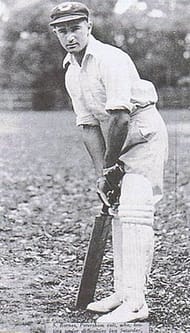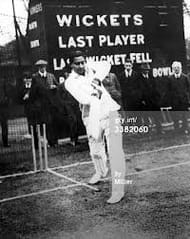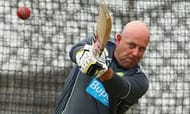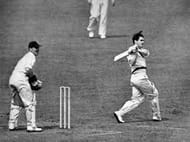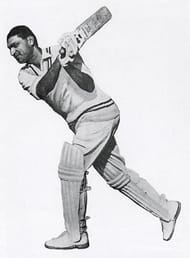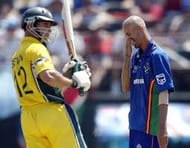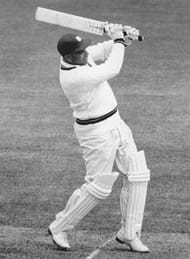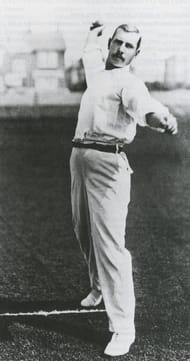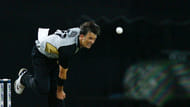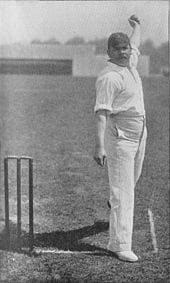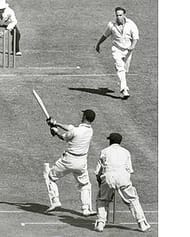Earlier this week, Wisden came out with its All-Time Test XI to commemorate its 150th anniversary. Since then, almost everyone from Michael Vaughan to my neighbour’s dog have come out with their version of the same in addition to the expected dose of criticisms and witticisms that are due when something of this nature is attempted.
It is indeed difficult to select a conclusive all-time eleven. It is almost equivalent to comparing cinematic blockbusters over the years. For example, would Sholay have been a bigger hit than 3 Idiots if it had released now? Secondly, my opinion of this issue may be vastly different than yours. I might consider an expert player of spin bowling more valuable than someone who can handle the short ball well.
I have thus decided to tread on safer territory and come up with my alternate version of an all-time Test XI. My list consists of players whose careers were not long enough to elevate them to the status of a great or who showed brief sparks of brilliance in a career ridden by mediocrity. My logic is that there was a method to this madness.
As I had pointed out in an earlier article, Sourav Ganguly averaged 66 at number 4, and had Sachin Tendulkar not been so persistent about his favourite position, we might have been reading a different chapter of cricket history today. Similarly, most of the players in my list would have had at least a couple of phenomenal performances and some are greats in their own right. Why I have classified them as a “would have been” is because I feel that their potential was not realized to the fullest in the role I see them in – be it better options available, selectors’ indiscretion, politics, injury, the “born in an era earlier” syndrome or perhaps even the player’s own naiveté. So here goes nothing.
I would have the duo of Barry Richards and Sid Barnes opening the batting for me. Richards divides the cricket world into two hemispheres – one which speculates what would have had been had he turned out for another country or had South Africa not been forced into sporting isolation and the other which reasons that, after such a bright start, he would have only gone downwards. Either way Richards remains one of the biggest enigmas of international cricket.
When you talk about Barnes in cricketing folklore, the other Syd (who made it to Wisden’s list) is the first name that comes to your mind. This does not make Sid any meaner as a cricketer. He played as an opener in 10 of his 13 Tests and all of his 3 centuries and four of his five half centuries came from this position. This includes the magnificent 234 which he made in collusion with the Don (who also coincidentally scored 234) in a world record partnership of 405 against Wally Hammond’s Englishmen.
Duleepsinhji played half of his 12 Tests at number 3 but made full use of the opportunity scoring two centuries along with three half centuries. On his day (which was quite frequent), he was the best player of slow bowling on wet rain-affected pitches which were more of a norm than an exception during his playing days.
At number 4 – the position I have talked about in so much detail over the last few days – comes my most left field selection. Boof may be more popular for his resemblance to Bruce Willis or his thoughts on Stuart Broad but Darren Lehmann was quite competent as a batsman in his heyday. The fact that he averaged almost 45 but was far from a regular in the Australian Test side tells as much about the bench strength of that particular team as of his bad luck at being born at a wrong time. For a period in 2003, he averaged over 90 with the bat at number 4 against West Indies and Bangladesh with a series of scores that reads like this: 160, 66, 96, 7,110, and 177. A year later, he was dropped from the team in favour of Michael Hussey.
Bringing back normalcy at number 5 is the calm and composure of Neil Harvey. Harvey started out as a number 6 but continued ascending the ladder literally as he spent the greater part of his career at number 4 before finishing at number 3. The reason for this out-of-turn promotion though was his exemplary performances at number 5. In only his second innings, Harvey produced a sterling 153 against India which made him the youngest Australian centurion at that time. He followed that up with a 112 from the same position in the celebrated Leeds Test of 1948. This was followed by 178 on the last day of the next year against South Africa in Cape Town followed by another famous knock of 151 at Durban. All this happened over a span of 12 Tests over two years. Almost ten years later when he again got a chance to bat at this position he made the most of it by cracking 54 against Pakistan in Karachi.
Number 6 is reserved for the batting all-rounder which leaves me in a bit of quandary. Ideally I would prefer a batsman who could be more than a handy bowler but, in extreme batting friendly (or bowling friendly) conditions, I would require the services of a full-time fifth bowler. For the former position, I would push for Polly Umrigar. Umrigar flitted around the batting order but still ended up with the most important numbers – most Tests, most runs, and most hundreds. As an off-spinner he was accurate; as a medium-pacer he could open the bowling and send down more than a part-timer’s share of outswingers. Add to that his versatility as a fielder and his shrewd captaincy and you would pity that he wasn’t born in a different era for India.
If however I needed someone who could bowl a little more than a little more, I would turn to Michael Bevan. I can hear the sneers already but, for his dismal Test record, one has to admit that Bevan was not utilised as properly as he should have been by the Australian selectors simply because they were spoiled by the problem of plenty. Being a chinaman, he was a difficult bowler to face up to which was exemplified in the series against West Indies in the ’97-’98 series where he upset their applecart by taking 15 wickets in addition to scoring a couple of crucial 80s before running out of partners. He was never someone who you could bet your life on against the short ball but this would not be too much of an issue as I would require his services only on turning pitches as a third spinner and hence by default as a batsman who can bat at six or lower.
This brings us to the selection of a wicketkeeper. Thirty years back I would have selected someone who was mercurial behind the stumps and efficient in front of them. Now, thanks to the likes of Gilchrist and Dhoni, I might have to go for someone who is the opposite – especially if I intend to play Bevan in the side. In case I do choose to place enough trust on my top six, I would go for a rank unknown. Had Steve Rhodes been a slightly better bat than he actually was, Alec Stewart might not have had a career. If England’s tour of India in ’88-’89 had gone to plan, Bumpy would have had a chance to don the Test gloves five years before he actually did. Even at 30, he showed his reflexes were intact by taking six catches and scoring 49 on debut. This was followed by his brilliant keeping to Devon Malcolm as the latter demolished South Africa at the Oval later that year. But, despite 49 victims in just 11 Tests, his batting remained sub-standard forcing the England selectors and me to have a rethink.
His “replacement” is much more famous and not a little bit because of his knighthood. Sir Clyde Walcott could walk into any Test team on the sheer dint of his batting but he could keep wicket as well and how. He played a third of his Test matches as designated keeper and managed to snare 38 batsmen including 11 stumpings most of which were of the bowling of the young spinners Gibbs and Ramadhin. This makes all the more sense if I am playing two and a half spinners. Walcott started out as an opener before juggling places with the other two Ws – Worrell and Weekes – in the middle order but he was a mighty fine lower middle order batsman too. The most memorable of his knocks at this positions was the historic 168 which helped West Indies beat England for the first time on English soil – an occasion which sparked celebrations the likes of which is not just rare but practically unimaginable today for any sporting event. Batting him at number 7 might be sacrilegious but I would tend to play him more often than not when Bevan is playing which means the two can swap places.
Which brings us to the bowlers. Before Syd Barnes, there was George Lohmann. If one was to summon the spirits of batsmen from the late 19th century and ask them who their greatest adversary was, not many would not take the name of Lohmann. Not that he was a speed merchant – in fact, far from it. Lohmann’s strength laid in seaming the ball both ways and he compounded the batsman’s misery by constantly experimenting with angle, flight and pace without compromising on his metronomic accuracy. He had a good eye for batting too and was brilliant in the slips. And rumours abound that most women at the turn of century went to watch England play only to see a “fair, blue-eyed, and handsome lad” play. Probably he should have been born a century later to have played more matches and won more female admirers.
His opening partner might be his anti-thesis as well. Shane Bond started out as a policeman but, a few years later, he was terrorising batsmen across the world with his extreme pace. Unlike his contemporary speedsters Akhtar and Lee, Bond had an action as smooth as a hot knife going through butter with no technical glitches. His career was cut short by multiple injuries which might have been avoided had he cut down on his pace. He refused to do so though which makes him an automatic candidate for my XI. Bond on his best was a sight to watch; it was a pity we got to see it so less.
Introducing spin into the attack would be Lohmann’s teammate Johnny Briggs. Briggs was a canny slow left arm orthodox but give him a slow wet turner and he could be lethal. Exactly half of his 118 wickets came as a first change bowler in 13 matches – these figures also include six 5 wicket hauls and three 10 wicket hauls. The most memorable of these would be the first time he got to bowl at this position. Australia were 45 for 1 when he started; when he finished with 5 for 29, they were 121 all out. He returned to take 6 wickets again in the second innings as Australia were well and truly trounced by an innings.
Finally my last choice would be a bowler who would hold fort in case Lohmann’s swing, Bond’s pace and Briggs’ wiles failed to mesmerise. With 109 wickets in 45 Tests, Ian Johnson isn’t the most obvious choice in a team chock-a-block with superstars but, as we have seen before, you need to have a stabilising influence to keep them grounded. It helped that Johnson was captain in 17 of the Tests he played although Australia lost most of those matches. The fault, though, was in the fact that the team he was leading was decidedly inferior to its predecessors. Johnson limited himself mostly to bowling as a fifth or even sixth option. His greatest successes, though, came from second change. In 15 Tests at that position he had picked up 57 wickets as opposed to 52 in the rest 30. Most of these successes came abroad – notably in West Indies and South Africa – where he probably felt more liberated as a bowler. This included his 5 for 34 in 1950 at Durban which helped Australia come up trumps against the home team.
The last task I have left to do is to select an option. Amongst the playing XI, only Umrigar and Johnson have captained their teams for a significant period of time. Even though it is of not of his own accord, Johnson’s miserable record as a leader does not inspire and I would rather have him as a visionary vice-captain to Umrigar’s leadership.
With that, I put the pen down or rather take my fingers off the keyboard. My team might be the Afghanistan of All-Time Test XIs but then every minnow has his day or two. And on his day, this David can upset many a Goliath (read: Wisden).
Brand-new app in a brand-new avatar! Download CricRocket for fast cricket scores, rocket flicks, super notifications and much more! 🚀☄️
